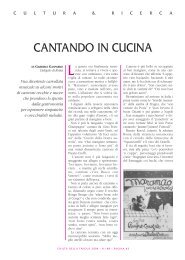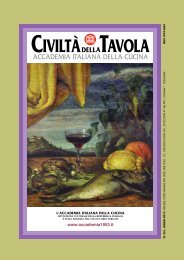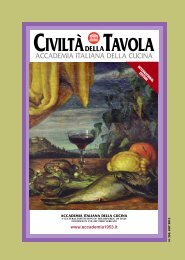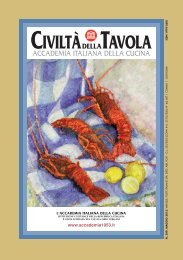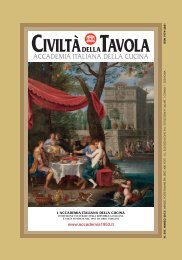Febbraio 2013 - Accademia Italiana della Cucina
Febbraio 2013 - Accademia Italiana della Cucina
Febbraio 2013 - Accademia Italiana della Cucina
Create successful ePaper yourself
Turn your PDF publications into a flip-book with our unique Google optimized e-Paper software.
Newspapers and television shows held<br />
competitions asking for ideas and advice,<br />
and the Academy even issued an official<br />
statement and participated in interviews.<br />
And so we got on board. But to be totally<br />
honest, it was only so much hot air.<br />
Nonsense. For centuries, every so often, in<br />
recurring cycles, books on leftovers have<br />
been published, starting with Olindo<br />
Guerrini’s historic book The Art of Cooking<br />
with Leftovers, a well written book that<br />
came out in 1918, to the many modern<br />
recycling manuals, like Letizia Nucciotti’s<br />
Forward People! The Art of Recycling<br />
Everything that is Leftover in your Kitchen. I<br />
also remember Master Chef Bruno Barbieri’s<br />
Passionate about Meatballs and Cooking<br />
without Waste by Andrea Segrè instructing<br />
us on how to utilize potato peels, wilted<br />
salad, spinach spines and fish heads. All<br />
well and good, but let’s be honest: no one<br />
sets a lavish holiday table for 10 Euros a<br />
person. We can save money on other days -<br />
every day - but not on Christmas and New<br />
Year. And we can spend less money today<br />
simply by not buying prewashed and<br />
chopped salad, sliced salami in plastic<br />
packages, take-out food from the<br />
gastronomy aisle, or rice that cooks in 3<br />
minutes. Seasonal vegetables really cost very<br />
little, poultry is reasonably priced, as are<br />
some farm-raised fish. In other words,<br />
recycling is important, but not always<br />
welcome by diners. What is fundamental is<br />
the art of grocery shopping. Modern<br />
supermarkets do everything in their power<br />
to make consumers overspend; they tempt<br />
us with superfluous, convenient and<br />
expensive foods. In reality, what we really<br />
need does not cost very much. We are the<br />
garbage generation: today between 45 and<br />
55 kilos (100 - 120 lbs.) of food per person<br />
is thrown away every year, along with 80<br />
(176 lbs.) kilos of paper, plastic and glass.<br />
Our shopping carts are filled with<br />
unnecessarily bulky packages that should<br />
have been minimized by the producers.<br />
Once upon a time there was hardly such a<br />
thing as garbage: pea pods were used to<br />
make a cream soup, cherry pits could be<br />
made into a liquor, and coffee grounds<br />
made an excellent fertilizer for plants. Even<br />
bones were made into soap. Fortunately<br />
some things are no longer necessary and<br />
we make pea pod soup because it’s<br />
delicious and makes us happy, not just to<br />
avoid generating trash.<br />
PAOLO PETRONI<br />
INTERNATIONAL SUMMARY<br />
EATING AS NATURE INTENDED<br />
see page 5<br />
From the sea to the table, Apuano<br />
Academician Alfredo Pelle describes the<br />
many ways Italians prepare and consume<br />
raw fish - not to mention Japanese sushi that<br />
is so in vogue today. While emphasizing the<br />
health benefits and “fresh from the sea taste”<br />
of raw foods, he also affirms that for<br />
centuries Italian cuisine has offered fish<br />
cooked using various techniques: a true<br />
expression of the ability and imagination<br />
of our cooks.<br />
MACAROONS<br />
see page 7<br />
Padua Academician Giancarlo Burri sheds<br />
light on the history and the authentic recipe<br />
for these cookies. The most creditable<br />
version states that macaroons were<br />
originally Italian and they were spread<br />
throughout France by Catherine de’ Medici,<br />
thanks to the Italian pastry chefs she<br />
brought with her to France.<br />
The idea of filling, however, was a French<br />
one, that today includes both the sweet and<br />
the savory.<br />
FROM FOOD TO POETRY<br />
see page 8<br />
On the occasion of the conference Food<br />
and Art organized by the Caltagirone<br />
Delegation, poet Maria Attanasio presented<br />
an in-depth study on the theme of food and<br />
poetry. The earliest protagonists were bread<br />
and of course wine, the very cornerstones<br />
of writing.<br />
The rise of mock heroes saw the beginning<br />
of a demystification and satirical genre of<br />
food in poetry that led to the subject’s<br />
complete legitimization between the end of<br />
the 1800s and the early 1900s when the<br />
futurists began to promote innovation and<br />
experimentation.<br />
A WELL ROUNDED ACADEMICIAN<br />
see page 10<br />
Upper Treviso Delegate Marca Nazzareno<br />
Acquistucci paints a portrait of Academician<br />
Anna Bellemo, who passed away in 1995.<br />
Raised in Montebelluno, she dedicated her<br />
life to the study of the history of the Veneto<br />
region and the civilization of the table.<br />
Her true passion, gastronomy, led her to<br />
CIVILTÀ DELLA TAVOLA <strong>2013</strong> • N. 246 • PAGINA 71<br />
become an Academician in the truest sense<br />
of the word, whose ability and wisdom made<br />
her a regional reference point.<br />
THE TASTES<br />
OF THE ANCIENT ROMANS<br />
see page 11<br />
In Roman times the essential nutritional<br />
elements were grains, vegetables, pork,<br />
olive oil, and a variety of spices and<br />
seasonings. Atri Academician Candida<br />
Sulpizi gives a detailed description of these<br />
products, focusing on their classification,<br />
use, conservation and diffusion among the<br />
ancient Romans.<br />
THE VALUE OF LENTILS<br />
see page 13<br />
Rome Academician Publio Viola provides an<br />
historical excursus on the lentil, from its<br />
origins to the present day, and describes<br />
this legume’s nutritional and health<br />
properties. Finally, he explains how to<br />
prepare them and suggests some traditional<br />
Italian recipes.<br />
PASTA AT THE MOVIES<br />
see page 15<br />
Taking inspiration from several books on<br />
the subject, Modena Academician Sandro<br />
Bellei presents a gallery of images and<br />
feelings about pasta as presented in Italian<br />
and foreign cinema.<br />
Starting with Sofia Loren in La Ciociara, he<br />
moves on to Alberto Sordi’s famous role in<br />
An American in Rome, Toto in Poverty and<br />
Nobility, Jack Lemmon in The Apartment,<br />
Visconti’s The Leopard and finally arrives at<br />
Sergio Leone’s celebrated “spaghetti<br />
westerns”.<br />
INSTRUCTIONAL BOOKS<br />
see page 16<br />
Avoiding the “informational overload” of the<br />
Internet, Cagliari-Castello Academician Also<br />
Vanini suggests that our collection of<br />
culinary manuals constitute the only<br />
authoritative source of knowledge.<br />
As examples he cites three “instructional<br />
books” that over the decades have provided<br />
not only recipes but also anecdotes,<br />
reflections and advice that illustrate<br />
the evolution of gastronomy and Italian<br />
society.



